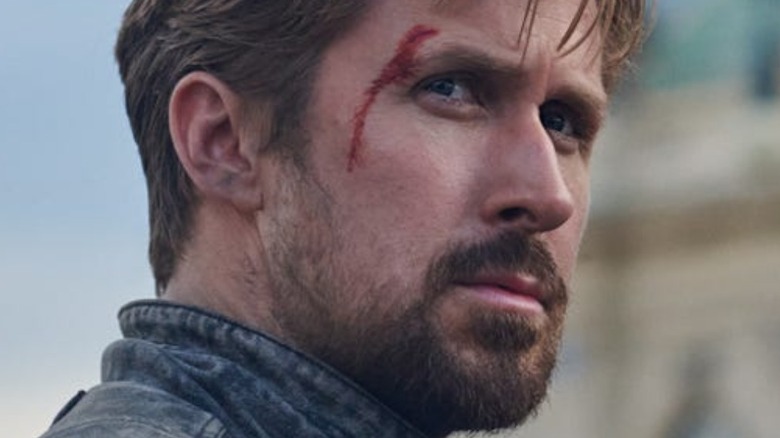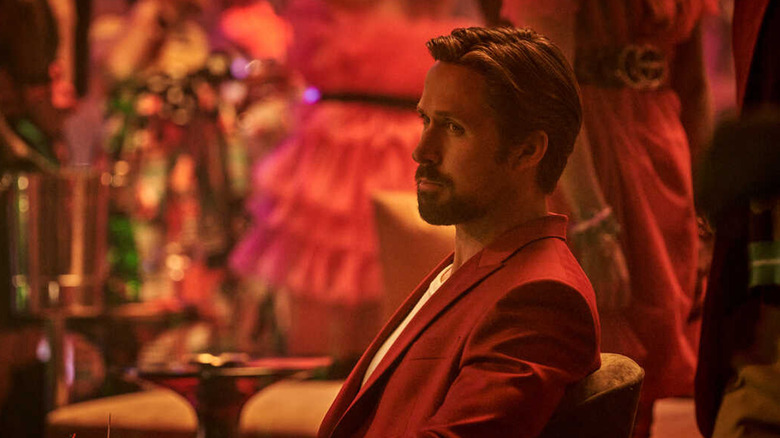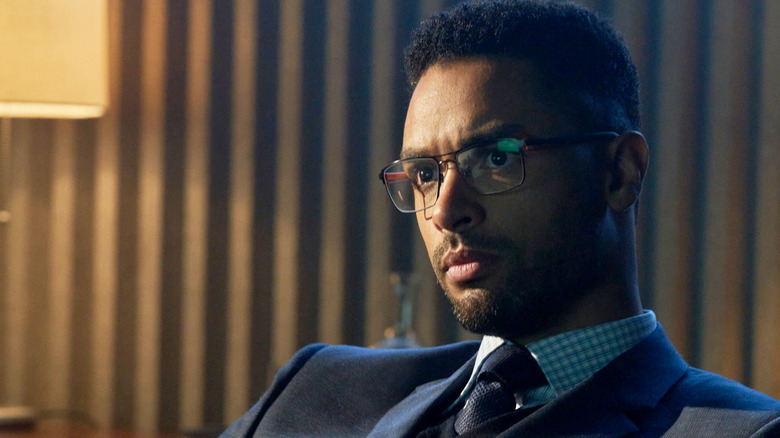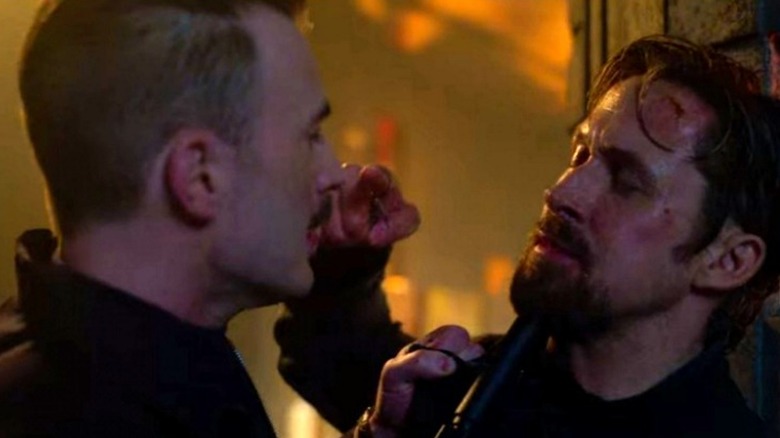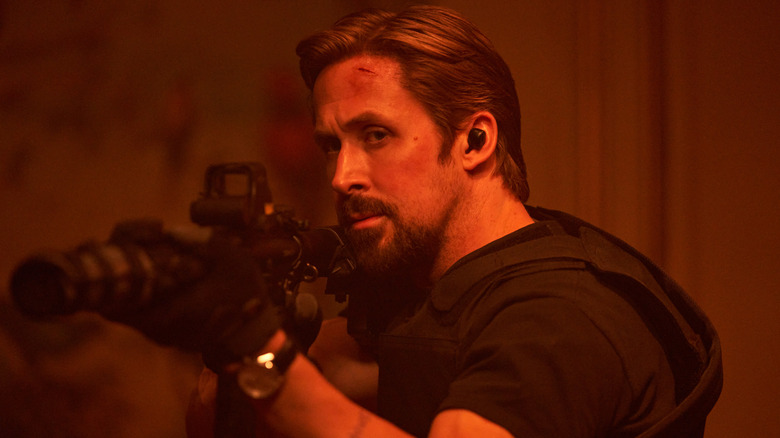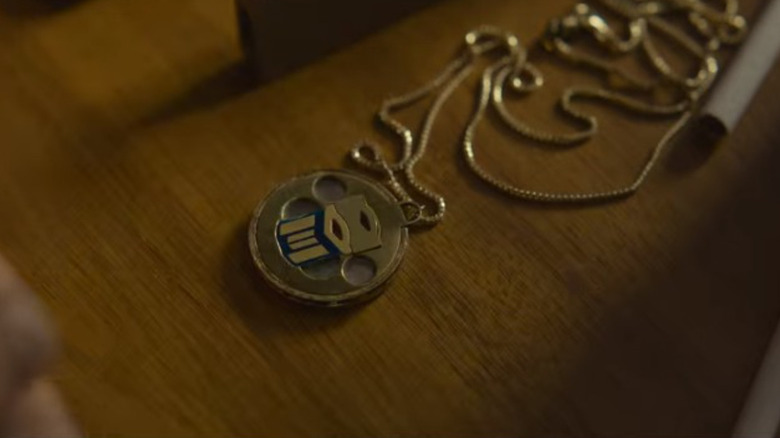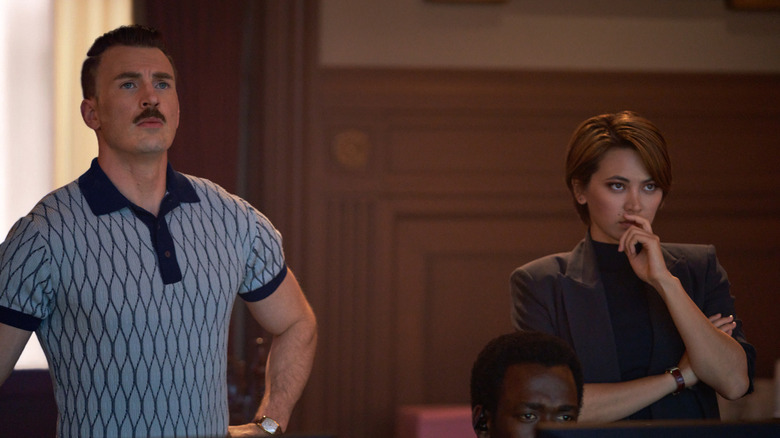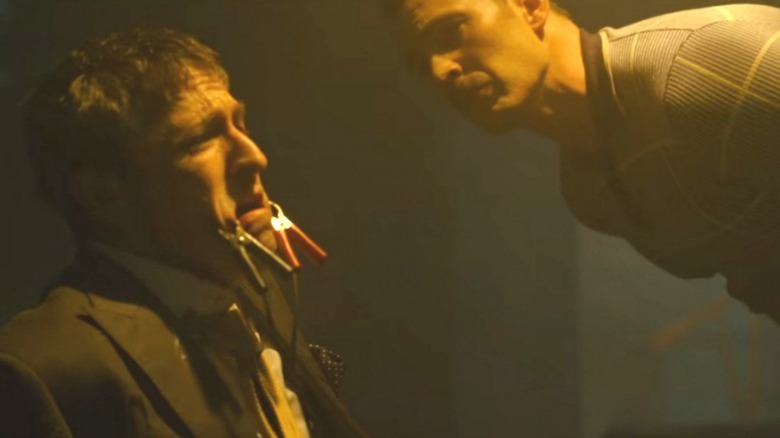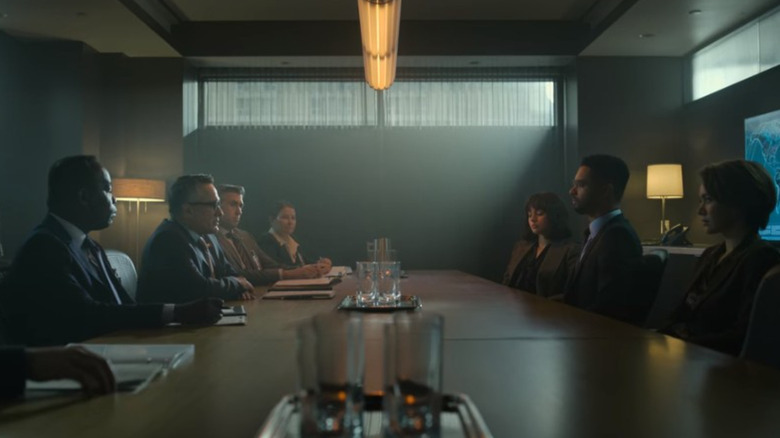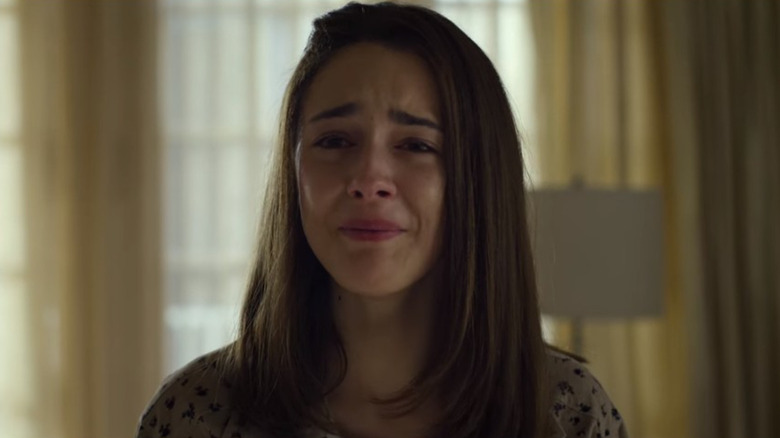Biggest Unanswered Questions In The Gray Man
After years in development limbo, "The Gray Man" has finally premiered on Netflix (after briefly hitting theater screens), dividing critics but generally wowing audiences with nearly non-stop, visceral action sequences. It's the first chance the Russo brothers have had to prove they can direct a satisfying, big-budget action movie without the foundation of the Marvel Cinematic Universe and its decades-long continuity to fall back on, after directing two "Captain America" installments, "Avengers: Infinity War," and "Avengers: Endgame" to record-shattering success. They still have the benefit of a stacked cast, including MCU heavyweight Chris Evans, Ryan Gosling, Ana De Armas, Regé-Jean Page, Jessica Henwick, Billy Bob Thornton, and Alfre Woodard. But "The Gray Man," an adaptation of a novel by Mark Greaney, has to sink or swim on the merits of its own, self-contained story.
That story doesn't have to do much heavy lifting in between gunshots, fistfights, and explosions, but it does ultimately leave you with some unresolved issues if you're following the details. The plot centers on an all-important flash drive, as so many CIA thrillers seem to do, in spite of the digital information age when you'd think sensitive intel would just live on the cloud. Does "The Gray Man" make enough sense to justify all the international mayhem it depicts, or is it just a bunch of sound and fury signifying nothing? Let's delve into the lingering mysteries and find out. These are the biggest unanswered questions in "The Gray Man."
Spoilers follow for "The Gray Man."
What happened at Winkie's Cantina?
In the very first scene, "The Gray Man" hits at a long list of crimes that have landed our protagonist Courtland Gentry (soon to be renamed Sierra Six as an assassin, or just "Six" to his friends) in jail for a long time. We later learn that he shot and killed his abusive father, which you might think wouldn't result in the typical 25-to-life sentence for homicide given the circumstances, but he makes an offhand remark implying that it wasn't his only run-in with the law. Before he realizes that the shadowy CIA official, Donald Fitzroy (Billy Bob Thornton), is there to grant him freedom if he agrees to work for him, he asks if the visit has something to do with "what happened at Winkie's Cantina."
Six (Ryan Gosling) vaguely explains that while he likes "honey buns," he wouldn't kill someone over them. But as the subject is quickly dispensed with, we're left with nothing but burning questions about Winkie's Cantina, and generally all of our protagonist's non-father-related past. Even once we learn the details about his father, it would be intriguing to know more about Six's history, and why he chooses this life over more prison time. Everyone loves a good confection, but how does a dispute over honey buns turn potentially fatal?
Who was the old man?
The indisputable villain of "The Gray Man" is Denny Carmichael (Regé-Jean Page), a Harvard grad and wunderkind who's become the head of the CIA a mere eight years after graduating. Plenty of people pull triggers and cause harm, but it's all on his orders, and it's all so a drive containing evidence of his own misdeeds isn't made public. But multiple references are made to "the old man," a presence even higher up in the government that has made his rise to power possible, and who is assumed to be monitoring all of the events we see.
Presumably with future sequels in mind, it's never revealed who this old man might be. It would have to be a high-ranking person indeed to pull the sort of strings that get such an inexperienced, shady operator appointed head of an entire branch of national intelligence. Logically, it would either have to be the President of the United States, who appoints the position, or at least someone in the current administration that has the President's ear. It's still just a looming mystery by the end of "The Gray Man." The only proof we have of the old man's clear and continuing power is Carmichael remaining in his job at the end of the movie, after having to cover up a spectacularly destructive operation.
What were Hansen and Six's dueling philosophies?
Despite the reference in its title, "The Gray Man" doesn't spend much time pondering the moral implications of operating in the gray area between right and wrong. There are some clues dropped about the deeper beliefs of its main hero and villain, however. When we meet the despicable Lloyd Hansen (Chris Evans), he's quoting the philosopher Arthur Schopenhauer: "Mostly it's loss which teaches us the worth of things." While he claims, somewhat accurately, that this means Schopenhauer saw "the value of suffering," it's pretty doubtful that the revered German thinker meant it as an endorsement of torturing people for information (and clearly also for Hansen's twisted pleasure). Schopenhauer was indeed a pessimist, but Hansen has taken his words to a cruel, nihilistic place that has nothing to do with his intent.
On the other hand, Six has a tattoo in Greek of the name Sisyphus. In the myth of Sisyphus, the king of Corinth angered the gods by cheating death, and was sentenced to eternally roll a boulder up a hill that would roll back down whenever he had nearly reached the top. In a famous 20th century work, "The Myth of Sisyphus," Albert Camus uses his plight as a representation of the human condition, and says that essentially it's our job to imagine Sisyphus happy, and find happiness in our own futility. This presumably is the sentiment that has helped Six get through his time in prison, and the much more humane approach he has to life than his polar opposite, Hansen.
Why are assassins surprised when kids are involved?
It's become a go-to cliché in action movies at this point: hired killer hesitates when a child is involved. At points in "The Gray Man," both Six and the supposedly even more ruthless independent mercenary Lone Wolf (Dhanush) have changes of heart immediately when children are potential collateral damage. It's compelling every time, sure, because certainly nobody watches these sorts of movies to see children get hurt. But after seeing it in countless shows and movies about assassins (see the "Wouldn't Hurt A Child" TV Tropes page for all the variations), you have to wonder: what did these people expect when choosing a life of unsanctioned, extra-legal killing?
When Lone Wolf changes his mind, he even explicitly states, "These are not honorable people." Buddy, you answered an open call on Shady Assassin Reddit to shoot off a bunch of guns in a hospital full of trauma victims. Now you're bringing moral judgment into this? Once again, it's not that children have it coming, certainly, but at what point are assassins in for a penny, in for a pound?
How did Miranda get to Vienna so quickly?
You have to feel for Ana De Armas's Agent Dani Miranda, who gets caught up in the machinations of the plot simply by being in the vicinity of Six during the opening operation. She gets called into a meeting with her snide boss Carmichael, who suspends her from duty just on an assumption of guilt by association. But she sees, reflected in Carmichael's glass, that Six has been captured in Vienna, and resolves to head there to save his life, so he can at least live to clear her name and restore her career.
But her speedy arrival in Vienna from Berlin, which is a seven-hour drive from her starting point of the German capital, is the only moment in "The Gray Man" that sets off the late-season "Game of Thrones" travel time alarm bells. How did she get there in what the editing of the film implies is perhaps a cool 45 minutes? She gets there only minutes after Hansen and his team of mercenaries, who had a head start and were already mid-air over Europe in a plane. Unless "The Gray Man" has a deleted scene where Miranda hops a plane or commandeers a helicopter, her saving Six in Vienna just in the nick of time doesn't compute.
Why couldn't they just email the drive to the press?
The central data drive, the all-important MacGuffin of "The Gray Man," is a magical device indeed. It's encrypted in such a specific way that it can't be copied, something Margaret Cahill (Alfre Woodard) refers to as a "dead disk," which means that if you try it will "encrypt the encryption." But why not just leak the contents of the drive to the press? Surely, since Cahill was able to open the drive in the first place, she at the very least could take pictures of her laptop screen with her phone or something.
Miranda mentions the need to go to the press briefly, but our heroes are of course interrupted by a hail of gunfire and one of the movie's many long action set-pieces intervenes. But why didn't Cahill just go ahead and leak the drive to the press in the couple of days she had it all to herself? Perhaps she wouldn't do anything without Six's okay, since he sent it to her. But it would be logical to assume that the drive full of incriminating evidence on the current head of the CIA is probably the reason Six is on the run in the first place, and if the contents were made public it would take some heat off him, and the Fitzroys in turn.
How complicit is Brewer in Carmichael's misdeeds?
Suzanne Brewer's (Jessica Henwick) role at the CIA isn't entirely specified, other than clearly being one of Carmichael's top people, as well as his scapegoat if things go south. For a lot of "The Gray Man," she seems like the voice of reason, alarmed at the growing mayhem Hansen's tactics are causing even before the fiasco in the square in Prague. But then she makes an abrupt turn to cover up everything and consolidate power for herself at the end of the movie. Other than not to be blamed for everything, it's not particular clear what she wants out of any of this.
The biggest unexplained variable is the degree to which Brewer would be implicated in whatever is on the drive. When Six and others discuss the contents briefly, it's only her boss Carmichael that seems to be implicated and damned by whatever else is contained on it, but as one of his top lackeys, it's likely she would be very complicit in Carmichael "using the CIA as his own personal death squad." In the end, it seems like her concern for collateral damage was only in regard to how much further she felt like it was putting her own neck on the chopping block with the powers-that-be.
When will movies learn torture doesn't work?
This is something that has been long-running in movies and television, but "The Gray Man" has a couple of torture scenes that reinforce the myth that it works as an interrogation technique. They're both mostly to prove what a heinous villain Hansen is — he's introduced clearly enjoying torturing a man on an unrelated job, and later removes several of Fitzroy's fingernails to get Margaret Cahill's identity as Six's contact in Prague out of him. It's certainly wrenching cinema, and Billy Bob Thornton really commits to screaming his head off. But, especially after we grappled with it as a country after the Iraq War and the "enhanced interrogation technique" scandal in our own military, these scenes make it hard to ignore the reality: torture doesn't work.
As reported by The New Scientist, "torture does not persuade people to make a reasoned decision to cooperate, but produces panic, dissociation, unconsciousness and long-term neurological damage." No matter how many pop culture examples, from TV shows like "24" to action movies like "Taken," want to believe in its effectiveness, torture just gets people to say anything you want to hear to make it stop, and not accurate intelligence.
What was Brewer's cover story exactly?
At the end of the big showdown, Brewer shoots and kills Hansen, then convinces Miranda and Six to agree to lie and blame Hansen for everything. It sounds simple enough, but makes absolutely zero sense when you stop and think about it. So the story is that Hansen, a ruthless CIA contractor, somehow stole millions of dollars worth of equipment and mercenary money, went rogue and blew up most of Prague in the process. But why? They have to tell the story that presumably covers up the existence of the drive, but what was the villainous Hansen even attempting to accomplish in this version of events?
"The Gray Man" skips over any of this to a conference room, where some dudes in suits (Congressional oversight perhaps?) are blithely accepting whatever the story was, calling it a "dark day" for the agency before just moving on. Meanwhile, dozens of Czech policeman were killed! This would be an international incident, and it seems insane to think some flimsy cover story could prevent Brewer and Carmichael himself from losing their jobs. It must be quite the cover-up, but sadly "The Gray Man" leaves us to imagine what the details were.
What was the historic property ruined during the finale?
During the climactic shootout, Hansen comically yells at Six, "You're making me ruin this historic property!" It is indeed a beautiful, palatial estate that "The Gray Man" spends half an hour appearing to destroy with gunfights and explosions. So where, in fact, is it? It turns out that the property isn't in Croatia, as the movie pretends, but in Chantilly, France, just an hour north of Paris. The Chateau de Chantilly is in fact a historic site deeply tied to the history of France.
According to its website, the Chateau de Chantilly was built in the Middle Ages and has belonged to several different families of French nobility over the years. It was restored after being destroyed in the French Revolution by Henri d'Orleans, a descendent of the last King of France. Today it operates daily as an art museum, and was not harmed during the filming of "The Gray Man."
Where do Six and Claire go from here?
All's well that ends well, as they say, but "The Gray Man" ends on a rather ambiguous note. After playing along with Brewer's insane cover story, Six has escaped CIA custody once again, and arrives to rescue Claire Fitzroy, whom Brewer is keeping under guard in order to control Six's actions. In one of the film's rare heartwarming moments after two hours of impersonal action sequences, Six makes a reference to the moment they met and they share a hug.
But as they drive off into the sunset, you might start to wonder what the rest of their lives could actually look like. Carmichael has destroyed the all-important drive, so they have no way to remove him from power or even intimidate him into leaving them alone. Dozens of innocent people have been killed during the events of the movie, including Claire's uncle and Six's mentor, and other than Miranda — who is probably tensely looking over her shoulder at all times at the CIA — they don't have any allies in the world.
How can they live on the run from the CIA and still get Claire the healthcare she needs for her pacemaker? It's generally a good thing that Six has proven himself to be more or less invulnerable and capable of anything, because at the end of "The Gray Man," it's just the two of them against the world.
